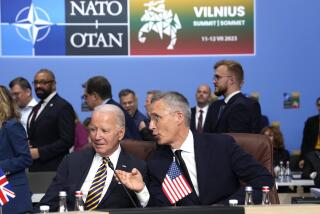A NATO for the ‘90s
- Share via
NATO was created nearly 50 years ago to provide for the collective defense of its 16 European and North American members in the face of a potential military threat from the Soviet Union. Today the Soviet Union is in history’s dustbin, the prospect of revived Russian militarism has become more a matter for academic discussion than a serious policy concern and the United States has withdrawn two-thirds of the 300,000 troops it once stationed in Western Europe. But NATO remains, an organization in the process of redefining itself and an alliance that virtually all of the former Warsaw Pact states of Eastern Europe are clamoring to join.
The terms for the “enlargement” that would enable NATO to take in some of these states are expected to be decided on by December. Meanwhile, in a meeting in Berlin this week, NATO has gone a long way toward reorganizing itself to deal with new challenges in a strategically changed world. Many details remain to be worked out, but the new NATO bodes to become a positive force for supporting stability and defending security in Europe.
The reshaped NATO will be able to operate outside of its traditional security area, as indeed it is now doing with its peacekeeping activities in Bosnia. Moreover, under a new concept called “combined joint task forces,” two or more NATO countries could commit their troops--with transport, communications and intelligence support from other members, meaning mainly the United States--to specific security missions. The role of NATO’s European members is certain to grow under this more flexible operational concept. That’s a major reason why France, which 30 years ago withdrew from NATO’s integrated military command structure in resentment over what it saw as U.S. dominance, is now preparing to expand its cooperation with the alliance.
U.S. involvement in NATO nonetheless remains essential to its effectiveness and in fact its survival as anything but a Cold War relic. However larger the new European role may be, it’s a given that no major operation will be possible without American approval or participation, not least because it’s the United States that owns most of the transport, satellite intelligence and communications equipment that NATO needs. It’s good that the Europeans at last are ready to do more to support security on their continent. It’s clear at the same time that leadership of the alliance seems destined to remain on this side of the Atlantic indefinitely.
More to Read
Sign up for Essential California
The most important California stories and recommendations in your inbox every morning.
You may occasionally receive promotional content from the Los Angeles Times.













